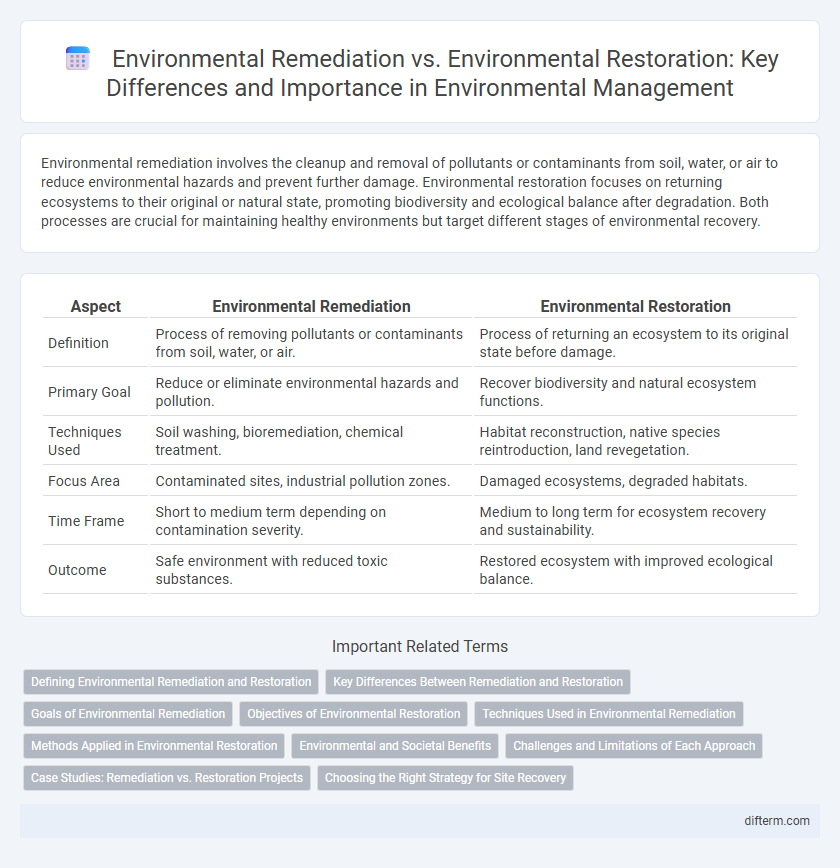Environmental remediation involves the cleanup and removal of pollutants or contaminants from soil, water, or air to reduce environmental hazards and prevent further damage. Environmental restoration focuses on returning ecosystems to their original or natural state, promoting biodiversity and ecological balance after degradation. Both processes are crucial for maintaining healthy environments but target different stages of environmental recovery.
Table of Comparison
| Aspect | Environmental Remediation | Environmental Restoration |
|---|---|---|
| Definition | Process of removing pollutants or contaminants from soil, water, or air. | Process of returning an ecosystem to its original state before damage. |
| Primary Goal | Reduce or eliminate environmental hazards and pollution. | Recover biodiversity and natural ecosystem functions. |
| Techniques Used | Soil washing, bioremediation, chemical treatment. | Habitat reconstruction, native species reintroduction, land revegetation. |
| Focus Area | Contaminated sites, industrial pollution zones. | Damaged ecosystems, degraded habitats. |
| Time Frame | Short to medium term depending on contamination severity. | Medium to long term for ecosystem recovery and sustainability. |
| Outcome | Safe environment with reduced toxic substances. | Restored ecosystem with improved ecological balance. |
Defining Environmental Remediation and Restoration
Environmental remediation involves the process of removing pollutants or contaminants from soil, water, or air to reduce environmental hazards and protect human health. Environmental restoration focuses on returning an ecosystem to its original, healthy state by reestablishing natural habitats, biodiversity, and ecological functions. Both strategies play crucial roles in managing environmental damage but differ in their primary objectives and methods.
Key Differences Between Remediation and Restoration
Environmental remediation involves the process of removing pollutants or contaminants from soil, water, or air to mitigate harmful effects, focusing primarily on hazard elimination. Environmental restoration aims to return an ecosystem to its original condition by reestablishing native species and natural processes, emphasizing ecological recovery and habitat rebuilding. The key difference lies in remediation addressing pollution cleanup, while restoration seeks to recover ecological integrity and biodiversity.
Goals of Environmental Remediation
Environmental remediation aims to identify, contain, and reduce pollutants or contaminants in soil, water, and air to protect human health and restore ecosystem functionality. This process prioritizes the removal or neutralization of hazardous substances resulting from industrial, chemical, or waste-related activities. Effective remediation minimizes ecological risks, prevents further environmental degradation, and ensures compliance with regulatory standards.
Objectives of Environmental Restoration
Environmental restoration aims to return ecosystems to their original state by reinstating native biodiversity and natural processes disrupted by human activities or natural disasters. The primary objectives include improving habitat quality, enhancing ecosystem services, and ensuring long-term ecological sustainability. This process often involves soil remediation, reforestation, wetland reconstruction, and water quality improvement to recover system functionality.
Techniques Used in Environmental Remediation
Techniques used in environmental remediation include bioremediation, soil vapor extraction, and chemical oxidation, targeting the removal or neutralization of contaminants from soil and groundwater. Physical methods like excavation and thermal treatment are often employed to isolate or destroy pollutants, enhancing site safety and usability. These remediation strategies are selected based on contamination type, site characteristics, and regulatory standards to effectively mitigate environmental hazards.
Methods Applied in Environmental Restoration
Environmental restoration employs methods such as reforestation, wetland reconstruction, and soil decontamination to recover ecosystems to their original conditions. Phytoremediation leverages plants to absorb toxins while bioremediation uses microorganisms to break down pollutants, both enhancing soil and water quality. Techniques also include erosion control, habitat reconstruction, and controlled burns to stabilize and improve biodiversity in degraded environments.
Environmental and Societal Benefits
Environmental remediation reduces pollutants and toxins in contaminated sites, directly improving public health and preventing ecosystem damage. Environmental restoration focuses on rehabilitating natural habitats to their original conditions, enhancing biodiversity and ecosystem services like clean water and air. Both approaches support societal well-being by promoting sustainable land use and resilience to climate change.
Challenges and Limitations of Each Approach
Environmental remediation faces challenges such as high costs, incomplete contaminant removal, and potential disturbance to ecosystems during cleanup processes. Environmental restoration often encounters limitations related to the complexity of reconstructing native habitats, time-intensive efforts for biodiversity recovery, and uncertainty in achieving pre-disturbance ecological conditions. Both approaches must address regulatory constraints, varying contamination levels, and long-term monitoring requirements to ensure effective ecosystem rehabilitation.
Case Studies: Remediation vs. Restoration Projects
Case studies in environmental remediation often highlight projects that target the removal of pollutants from contaminated sites, such as the remediation of the Hudson River PCB contamination, which involved dredging and containment strategies. In contrast, environmental restoration projects, like the Everglades Restoration Initiative, prioritize the recovery of natural ecosystems through reestablishing water flows and native habitats. Data from these case studies indicate remediation focuses on mitigating immediate hazards, while restoration aims for long-term ecological recovery and resilience.
Choosing the Right Strategy for Site Recovery
Environmental remediation focuses on removing contaminants from soil, water, or air to reduce pollution and health risks, while environmental restoration aims to return ecosystems to their original, natural conditions. Choosing the right strategy for site recovery depends on site-specific factors such as contamination levels, ecosystem types, regulatory requirements, and long-term sustainability goals. Effective site recovery often combines targeted remediation techniques like bioremediation or soil washing with restoration practices including native species replanting and habitat reconstruction.
environmental remediation vs environmental restoration Infographic

 difterm.com
difterm.com